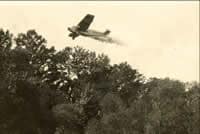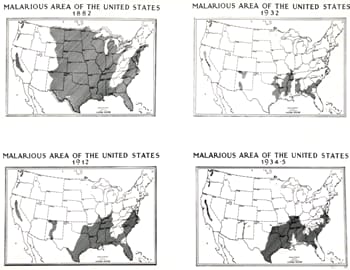Elimination of Malaria in the United States (1947 — 1951)
In 1951, the criteria for eradication as put forth by the National Malaria Society was: “Malaria may be assumed to be no longer endemic in any given area when no primary indigenous case has occurred there for three years.” Since then, the definition has evolved a bit. The term “elimination” is used when malaria transmission is no longer occurring in a specific geographic area. “Eradication” is used to describe elimination of malaria transmission worldwide.
CDC’s predecessor, the Office of Malaria Control in War Areas, had been established in 1942 to limit the impact of malaria and other vector-borne diseases (such as murine typhus) during World War II around military training bases in the southern United States and its territories, where malaria was still problematic. The center was located in Atlanta (rather than Washington, DC) because the South was the area of the country with the most malaria transmission.

Drainage activities, Virginia, 1920's

Aircraft spraying insecticide, 1920's
These efforts were so successful that at the end of the war and at the founding of CDC, one of the initial tasks was to oversee the completion of the elimination of malaria as a major public health problem.
The National Malaria Eradication Program was a cooperative undertaking by state and local health agencies of 13 southeastern states and the Communicable Disease Center of the U. S. Public Health Service, originally proposed by Dr. L. L. Williams. The program commenced operations on July 1, 1947. It consisted primarily of DDT application to the interior surfaces of rural homes or entire premises in counties where malaria was reported to have been prevalent in recent years. By the end of 1949, more than 4,650,000 house spray applications had been made. It also included drainage, removal of mosquito breeding sites, and spraying (occasionally from aircrafts) of insecticides. Total elimination of transmission was slowly achieved. In 1949, the country was declared free of malaria as a significant public health problem. By 1951, CDC gradually withdrew from active participation in the operational phases of the program and shifted its interest to surveillance, and in 1952, CDC participation in operations ceased altogether.
The role of CDC became one of surveillance within the U. S. and of assistance in the world-wide efforts to eliminate or control malaria in the economically underdeveloped areas of the world.

Distribution of malaria in the United States, 1882-1935. (Report for Certification and Registration of Malaria Eradication from United States of America published by PAHO/WHO, December 1969)
The goal of most current National Malaria Prevention and Control Programs and most malaria activities conducted in endemic countries is to reduce the number of malaria-related cases and deaths. To reduce malaria transmission to a level where it is no longer a public health problem is the goal of what is called malaria “control.”
Recent increases in resources, political will, and commitment have led to discussion of the possibility of malaria elimination and, ultimately, eradication.